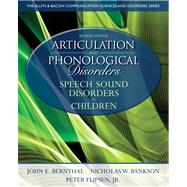
Note: Supplemental materials are not guaranteed with Rental or Used book purchases.
Purchase Benefits
What is included with this book?
Dr. Nicholas Bankson is a professor emeritus at James Madison University. He has had a forty year career as a speech-language pathologist, including employment in the public schools, serving as the state supervisor of school programs in Kansas, plus twenty-seven years as a department chair in Communication Sciences and Disorders at Boston University and James Madison University. His scholarly efforts have focused on speech sound disorders and the assessment of language disorders in children. He is an ASHA Fellow, and a recipient ASHA’s Honors of the Association award.
Dr. Peter Flipsen Jr., is a professor of Speech-Language Pathology at Idaho State University. He has more than twenty years of experience in the field as a clinician, teacher, and researcher. He teaches courses in phonetics and speech sound disorders in children and has published more than twenty peer-reviewed journal articles in the field. His research has focused on the classification of speech sound disorders, measurement of intelligibility of speech, and speech and language development in children with cochlear implants.
1. Introduction to the Study of Speech Sound Disorders
By Nicholas W. Bankson, John E. Bernthal, and Peter Flipsen Jr.
2. Normal Aspects of Articulation
By Ray Kent
Structure of Language
Fundamentals of Articulatory Phonetics
Coarticulation: Interactions among Sounds in Context
Aerodynamic Considerations in Speech Production
Acoustic Considerations of Speech
Sensory Information in Speech Production
Summary of Levels of Organization of Speech
Concluding Note on Implications for Speech Acquisition
Questions for Chapter 2
3. Speech Sound Acquisition
By Sharynne McLeod
Relevance of Understanding Typical Speech Sound Acquisition for SLPs
Models of Speech Acquisition
How Speech Acquisition Data Are Obtained
Overall Sequence of Speech Sound Acquisition
Phase 1: Laying the Foundations for Speech
Phase 2: Transitioning from Words to Speech
Phase 3: The Growth of the Inventory
Phase 4: Mastery of Speech and Literacy
Conclusion: Understanding and Applying Typical Speech Acquisition
Questions for Chapter 3
4. Classification and Comorbidity in Speech Sound Disorders
By Peter Flipsen Jr., John E. Bernthal, and Nicholas W. Bankson
Organically-Based Speech Sound Disorders
Childhood Apraxia of Speech
Speech Sound Disorders of Unknown Origin
Summary of Classification
Comorbidity
Conclusion
Questions for Chapter 4
5. Factors Related to Speech Sound Disorders
By Peter Flipsen Jr., Nicholas W. Bankson, and John E. Bernthal
Structure and Function of the Speech and Hearing Mechanism
Motor Abilities
Cognitive-Linguistic Factors
Psychosocial Factors
Conclusion
Questions for Chapter 5
6. Phonological Assessment Procedures
By Nicholas W. Bankson, John E. Bernthal, and Peter Flipsen Jr.
Speech Sound Sampling
Screening for Speech Sound Disorders
Comprehensive Speech Sound Assessment: The Assessment Battery
Related Assessment Procedures
Questions for Chapter 6
7. Determining the Need for Intervention and Target Selection
By John E. Bernthal, Nicholas W. Bankson, and Peter Flipsen Jr.
Case Selection
Target Speech Sound Selection
Other Factors to Consider in Case Selection: Intervention Decisions
Computer Assisted Phonological Analysis
Case Study
Questions for Chapter 7
8. Remediation Procedures
By Nicholas W. Bankson, John E. Bernthal, and Peter Flipsen Jr.
Basic Considerations
Making Progress in Therapy: Measuring Clinical Change
Facilitation of Generalization
Questions for Chapter 8
9. Motor-Based Treatment Approaches
By Peter Flipsen Jr., John E. Bernthal, and Nicholas W. Bankson
Approaches to Intervention
The Published Evidence
Treatment Continuum
Motor Learning Principles
Teaching Sounds
Beyond Teaching Sounds
Remediation Guidelines for Motor Approaches
Core Vocabulary Approach
The Use of Non-Speech Oral-Motor Activities
Intervention for Children with Childhood Apraxia of Speech
Case Study Revisited: Motor Perspective
Questions for Chapter 9
10. Linguistically-Based Treatment Approaches
By Peter Flipsen Jr., Nicholas W. Bankson, and John E. Bernthal
Minimal Pair Contrast Therapy
Cycles Approach
Broader-Based Language Approaches
Remediation Guidelines for Linguistically-Based Approaches
Case Study Revisited: Linguistic Perspective
Questions for Chapter 10
11. Language and Dialectal Variations
By Brian Goldstein and Aquiles Iglesias
Dialect
Characteristics of American English Dialects
Phonology in Speakers of Language Varieties Other than English
Phonological Development in Bilingual Children
Assessment Considerations for Children from Culturally and Linguistically Diverse Populations
Intervention for Speech Sound Disorders in Children from Culturally and Linguistically Diverse Populations
Summary
Questions for Chapter 11
12. Phonological Awareness: Description, Assessment, and Intervention
By Laura M. Justice, Gail T. Gillon, Brigid C. McNeill, and C. Melanie Schuele
What is Phonological Awareness?
Phonological Awareness as Literacy Development
The Development of Phonological Awareness
Phonological Awareness Development and Reading
Phonological Awareness and Speech Sound Disorders
The Role of the Speech-Language Pathologist
Assessment
Intervention
Phonological Awareness Experiences for Preschool Children at Preschool and at Home
Questions for Chapter 12
References
Appendix A
Appendix B
Author Index
Subject Index
The New copy of this book will include any supplemental materials advertised. Please check the title of the book to determine if it should include any access cards, study guides, lab manuals, CDs, etc.
The Used, Rental and eBook copies of this book are not guaranteed to include any supplemental materials. Typically, only the book itself is included. This is true even if the title states it includes any access cards, study guides, lab manuals, CDs, etc.